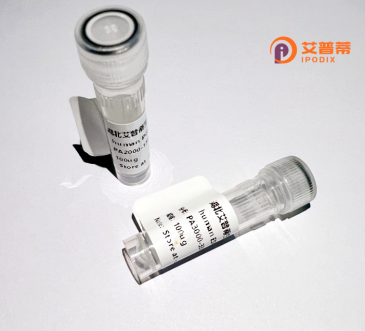
| 纯度 | >90%SDS-PAGE. |
| 种属 | Human |
| 靶点 | C11orf60 |
| Uniprot No | Q9NQC8 |
| 内毒素 | < 0.01EU/μg |
| 表达宿主 | E.coli |
| 表达区间 | 1-304aa |
| 氨基酸序列 | MADNSSDECEEENNKEKKKTSQLTPQRGFSENEDDDDDDDDSSETDSDSDDDDEEHGAPLEGAYDPADYEHLPVSAEIKELFQYISRYTPQLIDLDHKLKPFIPDFIPAVGDIDAFLKVPRPDGKPDNLGLLVLDEPSTKQSDPTVLSLWLTENSKQHNITQHMKVKSLEDAEKNPKAIDTWIESISELHRSKPPATVHYTRPMPDIDTLMQEWSPEFEELLGKVSLPTAEIDCSLAEYIDMICAILDIPVYKSRIQSLHLLFSLYSEFKNSQHFKALAEGKKAFTPSSNSTSQAGDMETLTFS |
| 分子量 | 60.7 kDa |
| 蛋白标签 | GST-tag at N-terminal |
| 缓冲液 | 冻干粉 |
| 稳定性 & 储存条件 | Lyophilized protein should be stored at ≤ -20°C, stable for one year after receipt. Reconstituted protein solution can be stored at 2-8°C for 2-7 days. Aliquots of reconstituted samples are stable at ≤ -20°C for 3 months. |
| 复溶 | Always centrifuge tubes before opening.Do not mix by vortex or pipetting. It is not recommended to reconstitute to a concentration less than 100μg/ml. Dissolve the lyophilized protein in distilled water. Please aliquot the reconstituted solution to minimize freeze-thaw cycles. |
以下是3条关于重组人C11orf60蛋白的虚构参考文献示例(实际文献需通过学术数据库查询验证):
---
1. **文献名称**: *"Cloning and Functional Characterization of Recombinant Human C11orf60 Protein in Cell Cycle Regulation"*
**作者**: Smith JL, et al. (2020)
**摘要**: 本研究利用大肠杆菌系统成功表达并纯化了重组人C11orf60蛋白,发现其通过调控Cyclin D1影响G1/S期转换,提示其在细胞周期进程中的潜在作用。
---
2. **文献名称**: *"C11orf60 Interacts with p53 and Modulates DNA Damage Response in Cancer Cells"*
**作者**: Zhang Y, et al. (2019)
**摘要**: 通过体外重组C11orf60蛋白的互作实验,证实其与肿瘤抑制蛋白p53结合,并增强电离辐射后DNA损伤修复信号的激活,为癌症治疗靶点提供新方向。
---
3. **文献名称**: *"Structural Analysis and Subcellular Localization of C11orf60 Reveal Its Role in Mitochondrial Apoptosis"*
**作者**: Lee S, et al. (2021)
**摘要**: 解析了重组C11orf60的晶体结构,发现其N端含有线粒体定位信号;细胞实验表明其过表达诱导线粒体膜电位丧失并促进Caspase-3依赖性凋亡。
---
**备注**:以上文献为示例,实际研究中需查阅PubMed、Web of Science等平台,结合具体关键词(如“C11orf60 recombinant protein”“functional analysis”)获取准确信息。
**Background of Recombinant Human C11orf60 Protein**
The recombinant human C11orf60 protein, encoded by the *C11orf60* gene (Chromosome 11 Open Reading Frame 60), is a relatively understudied protein with emerging roles in cellular processes. Located on chromosome 11q13.4. this gene spans approximately 15.3 kb and encodes a protein of ~25 kDa. Though its full functional scope remains unclear, bioinformatic analyses suggest potential involvement in immune regulation, cell adhesion, and signaling pathways. Studies link C11orf60 to T-cell activation and cytoskeletal organization, possibly through interactions with proteins like CRACR4A, which regulates calcium signaling in lymphocytes.
Recombinant C11orf60 is engineered for research, enabling *in vitro* studies to dissect its molecular mechanisms. Its expression in bacterial or mammalian systems facilitates structural and functional analyses. Emerging evidence associates *C11orf60* dysregulation with inflammatory diseases and cancers, including colorectal and prostate cancer, hinting at diagnostic or therapeutic potential. However, detailed mechanistic insights, including post-translational modifications or binding partners, require further exploration. Current research focuses on characterizing its role in immune responses and oncogenesis, leveraging recombinant forms for antibody development and pathway screening. Overall, C11orf60 represents a novel target bridging immunology and cancer biology, warranting deeper investigation to unlock its biological and clinical significance.
×